
Wine Culture and Information since 2002 - Volume 22
 Wine Culture and Information since 2002 - Volume 22 |
|
Issue 10, Summer 2003 |
Contents |
|
|
Summer Wines |
|
Summer has come and days are getting warmer and warmer, preparations for vacations are finally done and everyone is about to leave for those destinations that, hopefully, will give relaxing and tranquil moments. This is what is expected by the ones who decided to spend their summer somewhere else or can afford a vacation time. For all of us, wine lovers and lovers of nice wine, hopefully a little but good, no matter what was decided about how and where to spend summertime, whether at home in one's own city, or in sunny beaches or in the cool mountain breeze, we do not certainly forget, despite of the warm temperature, about that pleasure that a good wine can give. Summer days suggest and make people prefer cool beverages, those that can promise with their inviting temperature, a relief to the torments of hot, even foods, rightly, get adapted to the needs requested by the typical conditions of summertime. During this period in our tables are showing up foods made of vegetables, usually fresh salads, condiments get less and less heavy, the cooking of foods gets simpler and lighter and red wines, in particular the full bodied and “important” ones, usually matched with elaborated and rich foods, are being replaced by lighter wines. In this season there is an increasing consumption of white and sparkling wines, mainly because they are served at low temperatures and therefore they are more appealing. White and sparkling wines are practically associated to summertime, unfortunately they are served at too low temperatures, therefore losing, at these low temperatures, their best characteristics, in particular aromas, attenuated or annihilated by the rigid cold of refrigerators. Sparkling wines, with their joyous and vivid effervescence, seems to quench thirst and to give more satisfactions during the hot summer days and, in this season, are the fresher and younger sparkling wines, in particular the ones produced with the Charmat method, to be preferred best, generally as aperitifs. Besides these wines, there is also an increasing consumption of white wines and slightly sparkling wines, and this would confirm that in summertime effervescent beverages are the more successful ones. Even though in these periods red wines are usually “forgotten”, there is another style of wine which is forgotten as well and that could be very pleasing and fresh, certainly suited for summertime and not only in this season: rose wines. These type of wines have always been penalized because they are between the most common styles of wines usually referred as real wines, whites and reds, and for this reason they are probably never considered, indeed, they often are, unjustly, defined as low quality wines and for that worth of little interest. Rarely people remember about rose wines: it is true, they are not whites nor reds, they are rose, and they are however and indisputably wines. Nevertheless rose wines have unique and proper characteristics that make them perfectly suited for being between whites and reds, when a white wine is not enough and a red wine is simply too much, rose wine offers the right solution that can be adapted to many circumstances. Moreover they are wines usually consumed young, when they can express a pleasing crispness and fragrance of aromas, they can be served cool, sometimes at the usual temperatures of white wines. So, why not remembering about these wines and, hopefully, right in this summer? Rose wines are perfect with many dishes made of fish, in particular soups and roasts. If it is true that reds are temporarily “forgotten” during summertime, it is also true that not all reds are the same. Generally, when one thinks about red wines, the common idea is to think about full bodied wines, robust and thick, nevertheless there are so many red berried grapes that produce light wines, with little tannins and very pleasing to drink, particularly in summertime. Just like for rose wines, these wines can be served at low temperatures, certainly not like white wines, however at temperatures that will surely be pleasing in hot days, they perfectly match with the typical summer foods and have the fragrance and the crispness of fruit, flavors and aromas certainly welcome in summertime. Like rose wines, these type of wines are forgotten as well and they have little consideration, the personality of great red wines makes these wines appear as lesser wines, while usually forgetting that a full bodied red wine is not always suited for every circumstance. After all, the world of wine is amazing and interesting also thanks to the many and countless styles available. However, even in summertime, there also are occasions where a great red wine can be appreciated, most of the times during evening meals, when people usually spend more time in appreciating nice foods, there are many who do not renounce to the pleasure of a nice glass of full bodied red wine, even though it can result in a wrong food match, but, you know, the ones who like nice wine, when right occasions happen they always take advantage of them. What is important, no matter what wine you will choose for spending your summertime, is to always remember that moderation is the best way to appreciate the fascinating world of wine. We would like to wish our readers a happy summer, hopefully in company of a nice glass of wine, and we remind our readers we are going to take a break in august and the next issue of DiWineTaste will be published in September, in that period when the world of wine, at least the one of the northern hemisphere, will be greatly involved with new harvests. We also wish all wine producers that honored us with their trust, a very profitable harvest in the hope, and we do not have any doubt about that, they will be capable of giving us new emotions expressed in the magic of a glass. Happy summer vacations to you all and see you in September!
|
||||
MailBox |
|
In this column are published our reader's mail. If you have any comment or any
question or just want to express your opinion about wine, send your letters to
our editorial.
|
| I would like to know which red wines can be matched to dishes made of fish and served at a low temperature. |
| Claudio Daniele -- Vibo Valentia (Italy) |
| The so famous rule that fish must be matched with white wine exclusively represents, as a matter of fact, the most frequent choice, certainly not the only one. Even red wines can be happily matched with many dishes made of fish, in particular with roasts and soups, especially when are rich and elaborated. The scarce success and scarce spreading of the matching of red wines with fish is because of the “metallic” taste, usually not very pleasing, which is perceived in the mouth and this is believed to be a chemical reaction between phosphates present in fish and traces of iron bound to tannins, in particular to pigments. The matching of red wine and fish is however possible provided the chosen wine has little tannins, just like Pinot Noir, or that have been in contact with skins for a short time during maceration therefore avoiding tannins to be extracted. Red wines having some “crispness”, that is some acidity, are also suited as well and this characteristic is usually common in wines poor in tannins in order to have them balanced. If we consider the products available on the market, one can realize there are many red wines poor in tannins, a factor which also depends both by the kind of grape used and by the vinification technique. If a wine is poor in tannins, therefore it is also suited for being served at a low temperature; red wines are usually served at higher temperatures because astringency of tannins is exalted by cold, therefore a higher temperature makes this wines “smoother” and less aggressive. Another valid alternative for the matching of fish is also offered by rose wines, unfortunately not very considered, not only in the matching of fish, indeed they are extremely versatile and agreeable. |
| What is the difference between Sauternes and Barsac? |
| Douglas Hamilton -- New Castle (Australia) |
| These famous and precious wines are named after the two cities where they are produced, Sauternes and Barsac, in the southern area of Bordeaux's Graves, France. These two cities are involved in the production of sweet wines whose grapes, thanks to the climate conditions of those places, are being attacked by the “noble mold”, the so called Botrytis Cinerea. The two wines are to be considered of excellent quality and the grapes used for their production are the same, most of the times Sémillon and some Sauvignon Blanc and, sometimes, Muscadelle as well, whereas they differ for the production area. The two cities are located on the banks of Ciron river, which ends its course on the Garonne river, a favorable condition which allows the developments of the precious noble mold. Between the two commons, Sauternes is the largest and certainly also more famous, whereas Barsac is smaller, and this does not mean it is less prestigious. Grapes affected by Botrytis Cinerea are scrupulously harvested and then pressed in order to have a must which will be subsequently fermented and aged in cask for at least two years. At the end of this period the wine is bottled and usually sold, or further aged in producers' cellars. These wines are usually very longeval and can also stand to more than 30 years of aging while developing extraordinary characteristics. Both Sauternes and Barsac should never be consumed young, indeed they should be aged in bottle for at least 10 years in order to appreciate a development of the organoleptic characteristics. |
PortugalThe country of great Port and Madeira, excellent and magnificent fortified wines, is capable of offering an interesting production of white and red table wines as well |
|
Portugal, when considered as a wine producing country, is traditionally and indissolubly associated to its two most renowned wines, Port and Madeira, which made this country famous in every place of the world. Despite the fact Portugal is bound to its traditions about the production of wine and to its two main wines, from 1990s on, it largely demonstrated its indisputable value as a producer of table wines, in particular red wines, becoming one of the most important wine producing country of Europe in the international scene. Currently Portugal is, in terms of quantity, the fourteenth wine producer of the world and its internal consumption of wine is of about 47 liters per capita (about 12.4 gallons). The viticulture of the country is strongly bound to traditions and, for the production of certain wines, grapes are even pressed by feet in the traditional troughs called “lagares”. In many parts of the country, in particular in the hilly areas in the north and in the island of Madeira, the characteristics of the land, made of uncomfortable and steep slopes, only allow the harvesting of grapes by hand and this certainly is a very hard work. The wine production is basically based on local grapes; here the so called “international” grapes do not seem to have success, maybe because of the solid wine traditions of the country, however a tribute must go to Portugal because of its capability and skill of creating great wines, not only Port and Madeira, by exclusively using grapes that are present in its lands since ever.
The history of viticulture in Portugal is, for some aspects, at least in ancient times, affected by the facts that allowed the spreading of vine and wine in the Iberian peninsula. Vine and viticulture were probably introduced by Phoenicians and, in subsequent times, the development continued by Greeks and Romans. In the period of Moors dominations, the viticulture underwent a time of recession without being abandoned, mainly because of the economic advantages it could offer. The first development of enology and trade of the country started after the independence, in 1385, thanks to the flourishing and profitable commercial relations with England. However it was later, in 1693, that the enology of Portugal lived a long period of splendor, in particular because of the high taxes king William III imposed on French wines, as a consequence of war, therefore forcing English businessmen to look somewhere else for wines at a competitive prices, and found Portugal, having good relations with England since ever, as a good wine provider: the fame of Port wine started. In the beginning of the 1700s, the history of Portugal's enology is practically based on the facts about Port and Madeira wines, in particular for the evident preference English had for the consumption of this excellent wine. It was also thanks to the Methuen Treaty, an agreement signed in 1703 between England and Portugal which allowed the import of Portuguese wines in England at lower prices and therefore at the disadvantage of the wines of other European countries, first of all France, a commercial agreement which favored the development of Port and Madeira wines. In the Atlantic Ocean, the island of Madeira was a port of call for all those ships heading to the new world, and here they loaded the wine made in the island and therefore promoting its spreading. The invasion of French in the Iberian peninsula in 1803 was the beginning of a new conflict with England and, as a consequence, new and high taxes were imposed on French wine, therefore allowing Portuguese wine to be imported and sold at lower prices. These facts favored the spreading in England of some Portuguese wines, in particular the white Bucelas, the fortified Carcavelos and of a red wine simply referred as Lisbon. The period of splendor of Portuguese enology started to decline, living the same fate of the other European countries, at the end of the 1800s when the terrible phylloxera appeared and devastated the vineyards of the country, with considerable damages and in some areas of Portugal viticulture never resumed. Here, just like in other places, they tried to revive viticulture by planting hybrid species, however the development of Portuguese enology was heavily delayed also because of the political facts of the last century. In 1937 was established the Junta Nacional do Vinho with the purpose of founding cooperatives of producers in order to give a new impulse to the enology of the country. The results were good: in about 20 years were started more than 100 wine cooperatives, however restrictions imposed by central government did not allow the development they wished. As Portugal joined European Union in 1986, the enology of the country, also helped by economic investments, started a new development and a new course and from 1990s on the country has proved to have great potentialities in the production of wine, Port and Madeira certainly continue to be the leading characters of the Portuguese scene, however is the production of table wines what is surprising the world because of their indisputably quality.
|
||||||||
|
Wine production of Portugal is regulated by a system which is pretty similar to the French AOC (Appellation d'Origine Contrôlée) and that is called Denominação de Origem Controlada (Denomination of Controlled Origin), abbreviated as DOC. The laws and requirements which make the production disciplinary are set by Instituto da Vinha e do Vinho (Institute of Vine and Wine) helped by the many local commissions which control and set production rules for each area having a denomination of origin. The parameters on which are based Portuguese production's disciplinary usually define, as well as the geographical definition of the area, the total surface that can be cultivated with vines, the permitted grapes species, maximum harvests yields, wine making techniques, minimum periods of aging of wine before it can be released on the market and general indications to be written in the labels. It should be observed that Port and Madeira DOCs have proper governing authorities which set specific laws for the production of these wines. The categories being part of the systems are as follows, from the lowest level of quality to the highest:
Laws regulating the labeling of wines require the indication of the name of the DOC area and in case of mono varietal wines, that is produced with only one grape variety and expressly stated in the label, the wine must be produced with at least 85% of the named grape. In Portuguese wine labels there can also be found the following indications:
|
|
Wine production in Portugal is historically divided between table wines, mainly reds, and its two famous fortified wines, Port and Madeira. The country is mainly known for these latter wines, indeed the production of wine tables is extremely interesting and is getting, in particular during the last ten years, a high quality of indisputable value. Another famous wine of Portugal is the so called Vinho Verde, (green wine) produced both white and the less known red style, which can be appreciated best during its youth. In Portugal are cultivated hundreds of different species and in Douro, the renowned region of Port wine, are being cultivated more than 80. The majority of Portuguese grapes have very ancient origins and it is believed part of them were introduced in the country by Phoenicians. The cultivation of vine in Portugal certainly is not easy. The torrid summer climate and the critical fertile condition of the soil in certain areas, make the culture of vine pretty hard, moreover, in the north-eastern area of the country, in particular Douro, the aspect of the land is very steep, characterized by uncomfortable slopes where the cultivation of the vine can practically be defined as “heroic”. The phenomenon of the spreading of the so called “international” grapes did not seem to have significant effects in Portugal, here the production of wine is traditionally and strongly bound to local grapes, a rich patrimony of this country, which for many centuries, first of all with the Port and Madeira wines, has proven to have excellent potentiality. Among the most common white berried grapes in the country there are Alvarinho, Baul, Códega, Encruzado, Gouveio, Loureiro, Malvasia Fina, Pedernã, Rabigato, Sercial, Trajadura, Verdelho and Viosinho. As the country is mainly oriented to the production of red wines, including Port, the cultivation of vine is mainly about red berried grapes and the most important ones are Alfrocheiro Preto, Aragonez, Azal Tinto, Baga, Bastardo, Jaén, Periquita, Tinta Barroca, Tinta da Barca, Tinta Negra Mole, Tinta Roriz, Tinto Cão, Touriga Francesa, Touriga Nacional, Trincadeira Preto and Vinhao.
|
|
The Douro certainly is the most famous region of Portugal, in particular for the production of the renowned Port wine. The region goes along the course of the river having the same name and here the culture of vine is hard because of the conditions of the hilly lands and vineyards are planted in terraces built in the steep slopes. The region also produces interesting table wines, mainly reds, rich and full bodied, which are particularly appreciated among the wine lovers worldwide. Talking about the Douro region means talking, first of all, about the excellent Port, the famous fortified wine, the one who played the main role in the history of Portugal's enology. The grapes generally used for the production of Port are pressed by feet in large troughs, called lagares, according the ancient tradition with what they produced wine since ever. The must is usually left in contact of the skins for about one day and when almost half of the sugar has been transformed into alcohol, the fermentation process is stopped by adding ethyl alcohol, or brandy, with the result of neutralizing yeasts. The result of this operation is a sweet wine, with about 10% of residual sugar, with about 20% of alcohol by volume. At this point begins the most delicate and important process of the production of Port, the aging, which is also responsible for its style. Ports are essentially divided into two categories, the ones aged in cask and the ones aged in bottle. The styles of Port are about ten and we will briefly discuss the main characteristics of them. White Port is the most simple style and also the least appreciated and represents a minimal percentage of Port production. It is produced with white berried grapes, generally Códega, Gouveio, Malvasia Fina, Rabigato and Viosinho. White Ports are usually sweet and shortly aged in casks. Red Ports are generally produced with grapes Tinta Barroca, Tinta Roriz, known in Spain as Tempranillo, Tinto Cão, Touriga Francesa and Touriga Nacional. Ruby Port is the most simple style of red Port and it is usually aged in cask for two or three years, has a simple and fruity taste and is generally produced with the least valued grapes coming from the southern area of Douro. Tawny Ports are divided in two categories, very different one each other. Young Tawnies, simple and direct like Ruby Ports, are aged in cask for two or three years, have a light ruby color and are destined for an immediate consumption. Aged Tawnies have a higher quality and are produced with wines aged in casks for 10, 20, 30 years and often longer periods of time, have an extraordinary complexity and quality. Vintage Character, not to be confused with the more valued Vintage, are produced with Ports of different vintages and of different qualities, usually aged in casks for four or six years. Late Bottled Vintage, abbreviated as LBV, are Ports aged from four to six years in cask and then bottled, they are interesting wines of good quality. Traditional Late Bottled Vintage are produced in favorable years, are aged in cask for four years and then bottled. They are wines suited for a long aging in bottle even for twenty years. The most looked for and valued Ports certainly are Vintage, marked with the vintage and produced only in the best favorable years, are aged in cask for two years and then bottled. This style of wines are destined for a long aging, even for tens of years, and are the most expensive Ports as well as the most extraordinary ones. These wines can also be drunk during their youth, however their indisputable class and complexity will be revealed only by the patient work of time of at least ten years. Not very different are the Single Quinta Vintage, where the grapes used for their production are harvested in a specific Quinta, the name used in Portugal to refer to a property or an estate. Crusted Ports are produced with different wines of different vintages and in the label is usually stated the average age of all wines. These wines, just like Vintages, are not usually filtered and therefore have considerable quantity of sediments and need to be decanted. Garrafeira are to be considered as Port Reserve, only produced in the best favorable years, aged in cask for about two years and for some ten years in bottle. In the Douro region are also produced excellent table red wines, considered by many as the best red table wines of Portugal. Grapes used for the production of red table wines are basically the same used for Port as well as Tinta da Barca grape. These wines are generally robust and full bodied, have complex aromas and tastes, however there also are light and fruity Douro red wines. In the region are also produced white wines by using Gouveio, Malvasia Fina and Viosinho grapes.
|
||||
|
Wine production of this fascinating island of the Atlantic ocean is uniquely oriented to its prestigious and famous fortified wine. The island is located at about 850 kilometers south from Portugal (about 530 miles), west from the Moroccan coast. The harvesting of grapes for the production of Madeira is pretty hard because of the position of vineyards in steep slopes. The history of Madeira is pretty singular. At the end of the 1500s, the island was a port of call for commercial ships heading to the new world and here they used to load casks of the wine produced in the island. At those times Madeira wine was not fortified and casks were stowed in the ships and because of the high temperatures, at the end of the journey the wine was completely oxidized and “cooked”. In order to prevent this inconvenience, they thought of adding brandy to the wine in the aim of making it stand to the risks of a long journey. The wine was left in casks to age at the warm equatorial temperatures in ships' holds, and the preservative effect of alcohol helped to make it, at the end of a long journey, a rich and delicious wine: the myth of Madeira was born. The practice of “cooking” Madeira to the equatorial heat became a habit and was considered an essential part of the production process, and the best Madeiras were the ones which traveled for months in the ships' holds and for this reason they were called Vinhos de Roda, that is wines which left the island and traveled until getting back to the island, enriched and valued. Just like for the production of Port, some wine's alcohol is being added to the must while it is fermenting, neutralizing yeasts and leaving a considerable quantity of residual sugars to the wine. Nowadays Madeiras are not stowed in ships anymore and cooked by the torrid equatorial heat, however the “cooking” process is done by using estufas which also give the name to the estufagem process. The wine is being poured in a container, usually a wooden cask, and heated to a temperature of 40-45° C (104-113° F) for a period ranging from three and six months. It should be however observed that the process of heating of the best valued Madeiras is done without making use of any estufas, and it is done in a natural way by leaving casks in proper rooms under roof where the torrid heat of the island reaches high temperatures. In these conditions casks are usually left for long periods of time, often for tens of years, and at the end of this process the wine is moved to cooler rooms and then bottled. Grapes used for the production of Madeira are white and include Bual, Malmsey, Sercial and Verdelho. In the least valued Madeira is usually used the Tinta Negra Mole grape, a red berried grape. Casks used to age the wine are deliberately not filled entirely in order to encourage the process of oxidization which gives the wine its characteristic complexity. Madeira is produced in many styles, each one of them having proper qualities. The simpler Madeiras are usually produced with the Tinta Negra Mole grape, are rapidly heated for about 18 months and their color is usually because of the adding of caramel. Even three years old Madeiras, also known as Finest or Choice, are produced with the same method and are aged in steel or concrete tanks for about three years. Five years old Madeiras, also known as Reserve, are aged in cask and are usually produced with white berried grapes. Ten years old Madeiras, also known as Special Reserve, are usually produced with white berried grapes and are aged in cask. The same production method is used for fifteen years old Madeiras, also known as Extra Reserve. There is also a Madeira, whose production is getting more and more rare, made with the same method used for the Spanish Jerez and is known as Solera Madeira. The highest quality level is represented by Vintage Madeira, produced only with the grapes harvested in the vintage stated in the label and is aged for at least twenty years after having underwent the estufagem process. Vintage Madeiras are produced with white berried grapes only.
|
|
The region, bordering Spain, in the north-western part of the country, is mainly known for the production of Vinhos Verde, the renowned white wines of Portugal. The name Vinho Verde, literally green wine, has no connection with the color of the wine, which is also produced as red, but it simply refers to a young wine, not suited for aging, and that should be consumed as soon as it is being released on the market. For this reason, the majority of producers do not state the vintage in the label. Vinhos Verde are simple wines, light, having little alcohol and slightly effervescence, they usually are characterized by fruity and flowery aromas, and can be produced with one or more grapes, even up to twentyfive. Generally these white wines are produced with Alvarinho, Trajadura, Loureiro and Pedernã grapes. The slight effervescence in these wines is usually because of the presence of carbon dioxide added just before being bottled. Red Vinhos Verde are very popular in Portugal and they rarely are exported, are produced with many red berried grapes where Azal Tinto and Vinhão grapes are the most important ones.
|
|
Among the most interesting wine regions of Portugal it should be mentioned Dão, considered as one of the most promising areas of the country, which is located south from Douro and mainly produces red wines. The most cultivated red berried grapes of this region are Touriga Nacional, Tinta Roriz, Alfrocheiro Preto, Jaée and Bastardo, whereas the most cultivated white berried grape is Encruzado. Superior quality wines have Dão Nobre (Noble Dão) mentioned in the label. The Barraida region, which is located in the central part of Portugal, not very distant from the Atlantic ocean, is known for the production of red wines, where Baga grape is usually present, and for its red sparkling wines. Another interesting wine region of Portugal is Alentejo, located in the southern part of the country, where are mainly produced red wines with the grapes Periquita, Aragonez, the name used in this region to refer to Tempranillo, and Trincadera Preta.
|
Tasting Rose WinesRose wines are often neglected and not very appreciated, however they are pleasing and can give sensations which remind fruit's freshness |
|
Among the types of wines produced, roses are certainly the most neglected and least appreciated wines, they practically are hidden between white wines and red wines, however they are the perfect element which connects the two most common style of wines; when a white wine is “not enough” and a red wine is just “too much”, rose wine represents the ideal solution. It should be however remembered that the category of rose wines has been underrated in the past mainly because of a certain kind of restaurants, when they used to mix, without any kind of scruple, reds and whites together therefore creating a very bad quality product which certainly did not help to the success of rose wines. It must also be remembered there is a specific law, in force in almost every wine producing country of the world, which forbids the production of rose wine by mixing white and red wines, therefore this is a prejudice to be abandoned. Whether this is a warrant offered by any serious rose wines producer who sells its wine in sealed bottled, the same is not always guaranteed, unfortunately, for non bottled wine. In order to provide a complete information, it should be remembered that the mixing of white wines and red wines is only permitted for the production of rose sparkling wines elaborated with the classic method. Rose wines should be reevaluated and considered as real and proper wines, by recognizing them their status of real wine and this is not what unfortunately is happening. Rose wines are produced with proper and specific methods, just like for white wines and red wines or sparkling wines. The agreeability of these wines, to be consumed in their youth, in their best time, can be compared to the one of white wines; practically no rose wine is suited for the aging in bottle and they are wines expressly produced for being consumed soon after they are released on the market, after all, the same can be said for most of white wines. The reason why rose wines are not suited for the aging in bottle is because of the lack of preservative substances: these wines are generally less acid of whites and contain a quantity of tannins very inferior to the one of red wines. As rose wines should be consumed in their youth, they can give pleasing and fresh sensations, usually of fruit, that cannot be generally found in other kind of wines: a good reason for properly considering and reevaluating this too much neglected category of wines.
|
|
Contrary to the other types of wine, in general terms, the color in rose wines has no connection with aging, as they are usually consumed within one year or two from their production, indeed they are a sign of the technique used for their vinification, the grapes used and the area of origin. However these wines tend with time to get brown colors and nuances, a signal which indicates, not only the excessive aging, but also and particularly its oxidization, mainly because of the bad keeping practices and of high temperature. The main factor which determines the color in rose wines is the technique used for their production. There are two main systems for the production of these wines, both to be considered as real and proper vinification techniques. The first one consists in softly pressing red berried grapes in order to get a lightly colored must and soon after separated from skins. The second technique consists in macerating the skins on the must, just like any red wine, and allowing the contact for a relatively short period of time and enough to color the wine according to the type of product to be made. Using this method also adds a higher structure to the wine because of tannins being extracted from skins. The usual time spent for maceration is of about 6-12 hours, in this case wines are called “wines of one night”, up to 24 hours for wines called “wines of one day”. At the end of these initial procedures, vinification is completed by means of the usual white wine making techniques. Rose wines are not to be considered as “hybrid” wines or low quality red wines, they are real wines and produced with specific techniques. Defining a range of color for rose wines is pretty hard because their color is determined by many factors, in particular by the vinification technique, therefore the time of maceration and the species of grapes used. Typical colors can range from light pale pink up to light red, with a vast range of nuances in between. Evident orange, yellow or brown colors or nuances are usually the sign of an oxidized wine or however an excessive aging and these colors should never be found in a rose wine. A quality rose wine should always have a firm pink color, with no evident nuances, not excessively red, and even though this is not generally wished, a light nuance of orange or blue is however acceptable. Brown colors or nuances, and however colors resembling brown, are always and however to be considered as a negative factor, sign of oxidizations or excessive aging, in practice, the presence of this color is a clean sign that the wine has lost its best organoleptic qualities. The intensity of color in rose wines is generally a sign of the vinification technique used: wines made by just pressing grapes are lighter and paler than the ones produced with maceration.
|
||||
|
The main characteristic every rose wine should have is aromaticity. Despite the fact these wines does not usually have a considerable structure, the most pleasing aspect of tasting rose wines is certainly represented by their aromas. Considering the habit of consuming these wines when they are young, talking about the evolution of aromas in rose wines does not have any practical use, mainly because these wines offer their best organoleptic characteristics during their youth. Aromas of rose wines seems to be the connection point between white wines and red wines, in this type of wines there can be perceived the typical aromas of white wines as well as of red wines, therefore they will be typical aromas of rose wines. Aromas of flowers and fruit will be the most common types, however, according to the quality of grapes used, there can be perceived vegetal aromas as well and in the not so common case a producer decided to age its rose wine in cask, there can also be perceived spicy and toasted aromas. Even the most typical aromas in rose wines, the ones belonging to the family of flowers and fruit, mainly depend by the quality of the grapes used for their production, however the aromas that will be perceived will be similar to the ones of white and red wines produced with the very same grapes. Sometimes can also be found vegetal aromas, in particular aromas of bell pepper, walnut-husk and black currant leaf. Aromas of dried fruit are pretty rare in rose wines, however in many of them it is possible to perceive a clear and evident aroma of almond. Among the most common flower aromas in rose wines there are rose, violet, dried rose, hawthorn, wild rose, dog rose, peach flower, wild flowers, peony, jasmine, freesia, orange blossom, lime and broom. Among fruit aromas there are cherry, strawberry, raspberry, peach, black cherry, black currant, blackberry, banana, apple, plum, pear, blueberry, apricot, kiwi, medlar, pomegranate, orange, tangerine, grapefruit, litchi and pineapple.
|
|
Just like aromas, taste in rose wines must be pleasingly fresh as well; a rose wine lacking in acidity will always be flat and not very interesting, however a too much acid rose wine will be unpleasing and too much aggressive. Balance in this type of wine must be evaluated according to the production technique. The element which will be always present, certainly in proper and right quantities in order to balance its opposing elements, will be alcohol, useful in balancing acidity and any possible astringency because of tannins passed to wine during maceration in skins. Astringency in rose wines, when present, will always and however be moderate, far lower than the one of red wines, however, when it is present, acidity must be lesser. Even in case a rose wine has a perceptible astringency, acidity will however be the characteristic to be favored the most, just because everyone expects this characteristic from a rose wine. Even the taste-olfactory correspondence is a characteristic that should be common in these wines. In the mouth rose wines must have the freshness of flowers and fruits that was perceived by the nose, certainly completed by a pleasing crispness. Tannins will contribute to give body to the wine, however this aspect must not be excessive in order not to have a heavy and unpleasing wine.
|
|
In order to better understand rose wines, we will now have a comparative and practical tasting of three wines produced in different areas. To do the practical application explained in this section we will need a bottle of “Bardolino Chiaretto”, a rose wine from Salento and, lastly, a “Cirò Rosato”, all wines being of the latest vintage. These three Italian wines are produced with different grapes and in different areas: Bardolino Chiaretto is a wine from Veneto and is usually produced with Corvina, Rondinella and Molinara grapes; Salento Rosato is produced in Apulia with Negroamaro and Malvasia Nera grapes; whereas Cirò Rosato is produced in Calabria with Gaglioppo grape. The three wines will be served at temperatures ranging from 12 and 14° C (53.6-57.2° F). In rose wines the temperature plays a fundamental role and will be essential in particular to the perception of tastes: lower temperatures will tend to favor the perception of acidity and tannins, whereas higher temperatures will tend to favor roundness. In the appearance the three wines show pretty typical colors: Bardolino Chiaretto shows a rose color which is lighter than the other two, with nuances of cherry red; Salento Rosato will show a more firm color, an intense pink with nuances of cherry red; lastly, Cirò Rosato will probably be the one having a deeper color compared to the other two, it will more likely to have a color similar to the one of Salento Rosato. To the nose the three wines will have the typical characteristics of rose wines: freshness, fragrance and evident aromas of fruit and flowers. Bardolino Chiaretto will have aromas more oriented to fruit, in particular, raspberry, strawberry and cherry, however it will not be rare to perceive aromas of freesia, hawthorn and violet as well. Salento Rosato will have aromas oriented to fruits such as raspberry, strawberry, almond and peach as well as flower aromas of rose, jasmine and violet. Cirò Rosato will mainly characterized by fruit aromas, in particular cherry, raspberry, black cherry, strawberry and, sometimes, banana and peach as well. In this wine can also be perceived an aroma of rose. In the mouth the three wines will be very agreeable and pleasing, with a pretty evident freshness and crispness. Bardolino Chiaretto will be rounder, if compared to the other two, whereas Salento Rosato will seem to have a higher structure because of the higher contents in tannins, even though it will be the freshness to prevail over the other tastes. The same sensation will also be found in Cirò Rosato. The three wines will however be balanced and it will be interesting to paying attention to the evaluation of the intensity of acidity and astringency in regard to balance. The taste the three wines will leave in the mouth will be very agreeable with evident flavors of fruit and it will also be possible to perceive a clean flavor of almond.
|
Wines of the Month |
|
|
|
Score legend Prices are to be considered as indicative. Prices may vary according to the country or the shop where wines are bought |
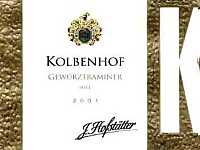
|
|
Alto Adige Gewürztraminer Kolbenhof 2001 |
|
| Hofstätter (Italy) | |
| Grapes: Gewürztraminer | |
| Price: € 19,30 | Score: |
| The wine is crystalline with an intense straw yellow color and nuances of straw yellow, very transparent. The nose is elegant, refined and of great personality with intense, rich, clean and persistent aromas such as apricot, pineapple, banana, passion fruit, broom, kiwi, litchi, honey, pear, peach, sage as well as an intense and pleasing typical aroma of the grape. In the mouth has an excellent correspondence to the nose and a magnificent balance. Alcohol, present in good quantity, is perfectly balanced by wine's acidity, flavors are very intense and agreeable. The finish is practically endless, very long and with strong, agreeable and clean flavors of peach, banana, pear, kiwi, honey and litchi. Simply a magnificent wine. This wine is produced with a short maceration of must in skins followed by a fermentation at a controlled temperature. | |
| Food Match: Crustaceans, Roasted spiced fish, pasta and risotto with fish | |
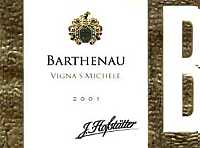
|
|
Alto Adige Bianco Barthenau Vigna San Michele 2001 |
|
| Hofstätter (Italy) | |
| Grapes: Pinot Blanc (70%), Chardonnay (25%), Sauvignon Blanc e Riesling (5%) | |
| Price: € 16,50 | Score: |
| The wine is crystalline with a straw yellow color and nuances of greenish yellow, very transparent. The nose reveals an aroma of wood, very refined and well integrated with other aromas and not intrusive at all. There can be perceived good and intense aromas of banana, hawthorn, litchi, apple, pear, peach, elder flower and vanilla, all very elegant, refined and pleasing. In the mouth is balanced with excellent correspondence to the nose, intense and crisp. Very agreeable. The finish is persistent with elegant flavors of vanilla, pear, apple and peach. A good wine. This wine is produced with fermentation of the grapes, part in steel tanks and part in barrique. | |
| Food Match: Appetizers, Risotto and pasta with fish, White meat | |
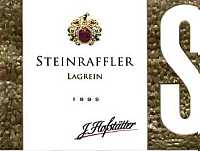
|
|
Alto Adige Lagrein Steinraffler 1999 |
|
| Hofstätter (Italy) | |
| Grapes: Lagrein | |
| Price: € 25,70 | Score: |
| The wine shows a beautiful and intense ruby red color and nuances of ruby red, moderate transparency. The nose reveals a long series of intense, complex, rich and pleasing aromas as well as good personality. There can be perceived good aromas of black cherry, anise, cocoa, coffee, toffee, carob, cherry macerated in alcohol, licorice, blueberry, black pepper, plum and vanilla. In mouth denotes a slightly crisp attack however well balanced and good correspondence to the nose. Smooth and agreeable tannins, intense flavors. The finish is persistent with good and pleasing flavors of black cherry, toffee, coffee and plum. A well made wine. This Lagrein is aged for 15 months in barriques, 6 months in casks and for at least 12 months in bottle. | |
| Food Match: Game, Hard cheese, Braised meat, Stewed meat | |
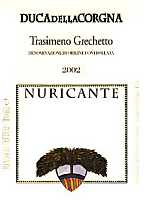
|
|
Colli del Trasimeno Grechetto Nuricante 2002 |
|
| Duca della Corgna (Italy) | |
| Grapes: Grechetto | |
| Price: € 4,80 | Score: |
| The wine shows a light straw yellow color and nuances of greenish yellow, very transparent. The nose reveals good personality with elegant, pleasing, intense and clean aromas of banana, hawthorn, kiwi, apple, honey, hazelnut, pear and citrus peel. In mouth has good correspondence to the nose and good balance, intense flavors and agreeable. The finish is persistent with flavors of pear and apple. Part of the must used to make this wine is fermented in barrique. | |
| Food Match: Fish appetizers, Pasta and risotto with fish, Roasted fish, Sauteed white meat, Soft cheese | |
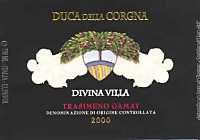
|
|
Colli del Trasimeno Gamay Divina Villa Etichetta Nera 2000 |
|
| Duca della Corgna (Italy) | |
| Grapes: Gamay | |
| Price: € 9,20 | Score: |
| The wine shows an intense ruby red color and nuances of ruby red, moderate transparency. The nose denotes intense, elegant, clean and pleasing aromas of black cherry, blackberry jam, raspberry, plum and black currant followed by pleasing aromas of licorice, violet, eucalyptus and vanilla. In mouth reveals good correspondence to the nose, an alcoholic attack however well balanced by tannins, intense flavors and good body. The finish is persistent with pleasing flavors of plum, black cherry and black currant. A well made wine. This Gamay ages for about 12 months in barrique followed by 7 months in bottle. | |
| Food Match: Game, Roasted meat, Braised meat, Stewed meat, Hard cheese | |
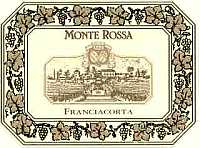
|
|
Franciacorta Prima Cuvée Brut |
|
| Monte Rossa (Italy) | |
| Grapes: Chardonnay, Pinot Blanc (85%) Pinot Noir (15%) | |
| Price: € 13,00 | Score: |
| The wine shows an intense greenish yellow color and nuances of greenish yellow, fine and persistent perlage. The nose reveals intense, pleasing and elegant aromas of citrus fruit, yeast, butter, hawthorn, almond, apple, pear, banana and peach. In mouth has good correspondence to the nose, a crisp attack however well balanced, appreciable effervescence, intense flavors. The finish is persistent with flavors of almond, citrus fruit and pear. This Franciacorta is produced with wines partially aged in barrique and stays in contact of the lees for at least 24 months. | |
| Food Match: Soft cheese, Pasta and risotto with fish, Crustaceans | |
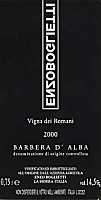
|
|
Barbera d'Alba Vigna dei Romani 2000 |
|
| Enzo Boglietti (Italy) | |
| Grapes: Barbera | |
| Price: € 33,00 | Score: |
| A magnificent Barbera! This wine shows a beautiful deep ruby red color and nuances of ruby red, little transparency. The nose reveals great personality with intense, clean, elegant and refined aromas where it can be perceived a clear hint of toasted wood which does not disturb the perception of other aromas. There can be perceived good aromas of black cherry jam, cherry jam, plum jam, raspberry, black currant and dried violet followed by good and intense aromas of cocoa, toffee, licorice, vanilla and toasted wood. In mouth reveals excellent correspondence to the nose, a slightly tannic attack however balanced by alcohol and acidity of Barbera. Intense flavors and full body. The finish is very persistent with long and clean flavors of black cherry, plum and toasted. A truly great wine and very well made. Vigna dei Romani is aged for 16 months in barrique and for 4 months in bottle. | |
| Food Match: Game, Braised meat, Stewed meat, Roasted meat, Hard cheese | |
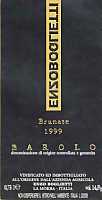
|
|
Barolo Vigna delle Brunate 1999 |
|
| Enzo Boglietti (Italy) | |
| Grapes: Nebbiolo | |
| Price: € 52,00 | Score: |
| Excellent Barolo! The wine has a beautiful and intense garnet red color and nuances of garnet red, moderate transparency. The nose reveals personality with intense, clean, pleasing, elegant and refined aromas of cherry, violet, strawberry jam, raspberry jam and plum jam followed by good and intense aromas of chocolate, leather, licorice, menthol, tobacco and vanilla. In mouth denotes a tannic attack however balanced, good correspondence to the nose, intense flavors and full body. The finish is very persistent with long and clean flavors of cherry, plum and raspberry. A great and well made wine that will give its best with further years of aging in bottle. This Barolo ages for 30 months in cask followed by 8 months of aging in bottle. | |
| Food Match: Game, Braised meat, Stewed meat, Roasted meat, Hard cheese | |
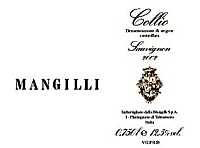
|
|
Collio Sauvignon 2002 |
|
| Mangilli (Italy) | |
| Grapes: Sauvignon Blanc | |
| Price: € 7,60 | Score: |
| The wine shows a light straw yellow and nuances of greenish yellow, very transparent. The nose has personality with elegant, intense, clean and pleasing aromas, mainly of flowers, such as chamomile, chrysanthemum, carnation, yellow rose and elder followed by good aromas of apple, pear, peach, tomato leaf, bell pepper and basil. In the mouth is balanced, very agreeable with intense flavors. The finish is persistent with flavors of apple, peach and pear. A well made wine. This Sauvignon Blanc is fermented in steel tanks and ages for at least 30 days in bottle. | |
| Food Match: Appetizers, Fish, Crustaceans, Pasta and risotto with vegetables and fish | |
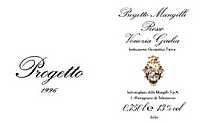
|
|
Progetto 1996 |
|
| Mangilli (Italy) | |
| Grapes: Cabernet Sauvignon (60%), Cabernet Franc (20%), Merlot (20%) | |
| Price: € 14,30 | Score: |
| The wine has an intense ruby red color and nuances of garnet red, little transparency. The nose reveals personality with intense, clean, elegant and refined aromas of black cherry, strawberry jam, raspberry jam, blackberry jam, plum jam, blueberry and violet followed by good aromas of vanilla, licorice and cocoa. In the mouth has good correspondence to the nose, a slightly tannic attack however well balanced by alcohol, intense flavors and full bodied. The finish is very persistent with good and pleasing flavors of black cherry, plum, blueberry and raspberry. Progetto ferments in steel tanks and ages in casks for 2 years followed by an aging in bottle for at least 12 months. | |
| Food Match: Roasted meat, Game, Braised meat, Hard cheese | |
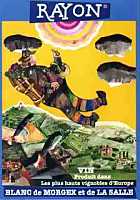
|
|
Vallée d'Aoste Blanc de Morgex et de La Salle Rayon 2002 |
|
| Cave du Vin Blanc de Morgex et de La Salle (Italy) | |
| Grapes: Blanc de Morgex | |
| Price: € 7,60 | Score: |
| A white of great elegance. The wine shows a beautiful brilliant greenish yellow color and nuances of greenish yellow, very transparent. The nose reveals good personality and a series of intense, elegant, very refined, clean and pleasing aromas of citrus fruit, pineapple, hawthorn, acacia, broom, litchi, apple, pear, peach and plum as well as a pleasing hint of anise. In mouth is very agreeable with a crisp attack well balanced by alcohol, intense flavors and excellent correspondence to the nose. The finish is very persistent with long and pleasing flavors of pear, peach, litchi and pineapple. A very elegant and well made wine. | |
| Food Match: Pasta and risotto with fish, Fish soup, Sauteed white meat, Soft cheese | |
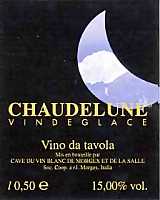
|
|
Chaudelune Vin de Glace |
|
| Cave du Vin Blanc de Morgex et de La Salle (Italy) | |
| Grapes: Blanc de Morgex | |
| Price: € 15,00 (500 ml - 16.9 fl.ozHard cheese, Confectionery, Dried fruit or almond tarts | Score: |
| The wine shows a light golden yellow color and nuances of straw yellow, very transparent. The nose has clean, pleasing, intense and elegant aromas of dried apricot, peach jam, almond, cooked apple, cooked pear, honey, candied fruit, citrus fruit peel and vanilla as well as an aroma of toasted wood. In mouth reveals good correspondence to the nose, a crisp attack however well balanced, intense flavors and smoothness. The finish is persistent with flavors of peach, honey and pear. Chaudelune is produced with grapes harvested at temperatures below zero and is fermented in barrique followed by a long aging in bottle. | |
| Food Match: Hard cheese, Confectionery, Dried fruit or almond tarts | |
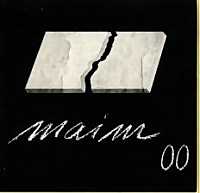
|
|
Garda Classico Groppello Maim 2000 |
|
| Costaripa (Italy) | |
| Grapes: Groppello | |
| Price: € 10,35 | Score: |
| The wine has a brilliant ruby red color and nuances of ruby red, moderate transparency. The nose reveals intense, clean and pleasing aromas of black cherry, blueberry, blackberry and plum followed by good aromas of vanilla where good aromas of wood are also perceived. In mouth denotes good correspondence to the nose, a slightly tannic attack however balanced, good body and intense flavors. The finish is persistent with flavors of black cherry, blueberry and plum. Maim Ages in cask for at least 12 months followed by at least 10 months of aging in bottle. | |
| Food Match: Stuffed pasta, Meat with mushrooms, Roasted meat, Broiled meat and barbecue, Hard cheese | |
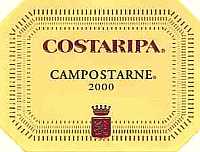
|
|
Garda Classico Campostarne 2001 |
|
| Costaripa (Italy) | |
| Grapes: Groppello, Marzemino, Merlot, Cabernet Sauvignon | |
| Price: € 5,00 | Score: |
| The wine shows a brilliant ruby red color and nuances of ruby red, moderate transparency. The nose denotes personality with intense, clean and elegant aromas of black cherry, raspberry, blueberry and plum followed by aromas of vanilla and violet as well as hints of smoke and toffee. In mouth reveals good correspondence to the nose, good balance and body as well as tannins in good evidence. The finish is persistent with flavors of raspberry, blueberry and plum. | |
| Food Match: Stuffed pasta, Roasted meat, Broiled meat and barbecue, Hard cheese | |
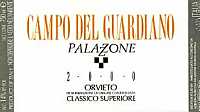
|
|
Orvieto Classico Superiore Campo del Guardiano 2000 |
|
| Palazzone (Italy) | |
| Grapes: Procanico (50%), Grechetto (25%), Verdello, Drupeggio and Malvasia Bianca (25%) | |
| Price: € 9,00 | Score: |
| The wine shows a beautiful light straw yellow color and nuances of greenish yellow, very transparent. The nose has intense, clean, elegant and pleasing aromas of hawthorn , broom, almond, apple, medlar, hazelnut, pear and peach as well as a pleasing hint of rosemary. In the mouth reveals good correspondence to the nose, a crisp and round attack however well balanced by alcohol, good body and intense flavors, agreeable. The finish is persistent with good flavors of apple, pear and peach. This Orvieto Classico is ages in bottle for 16-18 months. | |
| Food Match: Roasted fish, Crustaceans, Pasta and risotto with fish, Sauteed white meat, Soft cheese | |
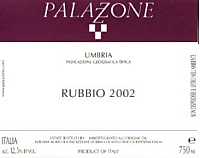
|
|
Rubbio 2002 |
|
| Palazzone (Italy) | |
| Grapes: Sangiovese (70%) Canaiolo, Montepulciano (30%) | |
| Price: € 7,00 | Score: |
| The wine shows a brilliant ruby red color and nuances of ruby red, moderate transparency. The nose reveals good personality with intense, clean, elegant and pleasing aromas of cherry, strawberry, raspberry and violet followed by pleasing aromas of rose as well as hints of peach. In mouth has good correspondence to the nose, a slightly tannic attack however balanced by alcohol, intense flavors and agreeable. The finish is persistent with pleasing flavors of raspberry and cherry. Rubbio ages for 6 months in barrique and for 2 months in bottle. | |
| Food Match: White roasted meat, Sauteed meat, Hard cheese | |
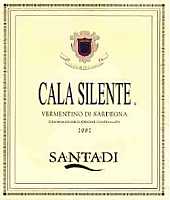
|
|
Vermentino di Sardegna Cala Silente 2002 |
|
| Santadi (Italy) | |
| Grapes: Vermentino | |
| Price: € 6,24 | Score: |
| The wine shows an intense straw yellow color and nuances of greenish yellow, very transparent. The nose reveals pleasing, intense and clean aromas of banana, broom, wistaria, kiwi, lemon, pear, apple, gooseberry followed by good aromas of fennel and vanilla. In mouth denotes good correspondence to the nose, good balance, intense flavors, agreeable. The finish is persistent with good flavors of apple, banana and pear. Cala Silente partly ages in barrique and partly in steel tanks. | |
| Food Match: Stuffed pasta, White meat, Fried vegetables, Fish, Soft cheese | |
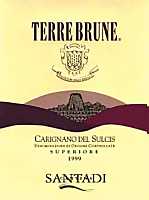
|
|
Carignano del Sulcis Superiore Terre Brune 1999 |
|
| Santadi (Italy) | |
| Grapes: Carignano (95%), Bovale (5%) | |
| Price: € 24,00 | Score: |
| The wine shows an intense ruby red color and nuances of garnet red, little transparency. The nose reveals personality with intense, elegant, clean and refined aromas, very pleasing, of strawberry jam, blackberry jam, peach jam, raspberry, blueberry, plum, iris and violet followed by good aromas of carob, vanilla, licorice and mint. In mouth denotes good correspondence to the nose, round and smooth, very balanced, full body and intense flavors. The finish is persistent with pleasing and clean flavors of plum, blueberry and peach jam. A well made wine. Terre Brune is aged for 15-18 months in barrique and for 12 months in bottle. | |
| Food Match: Roasted meat, Broiled meat and barbecue, Stewed meat, Hard cheese | |
Casale del GiglioTwenty years of researches for the discovery of the potentialities of a territory capable of producing great quality wines |
|
Twenty years have passed since Casale del Giglio decided to start an ambitious project of research and experimentation with the declared goal of discovering and valuing the viticultural and wine potentialities of the “Agro Pontino”, a territory reclaimed in the 1930s and therefore new and open to any kind of development and culture. With the help of a qualified group of experts it started a series of researches and analyses on the ecosystem of those lands while trying to discover, by means of an accurate experimentation, the possibilities of the evolution according to an enological point of view. As the viticulture of that land is relatively new, and therefore not bound to any specific tradition, the adopted models for the production of wine were the ones inspired to the international ones and typically used in the countries of the New World. After about twenty years of continued researches and continued successes, Casale del Giglio has been successful in producing great wines with international grapes as well as with grapes not particularly popular, such as Petit Verdot, capable of surprising for their excellent quality.
Casale del Giglio winery was established in 1968 by Dr. Bernardino Santarelli and is located in Le Ferriere, in the province of Latina (Italy), and in the beginning was mainly involved in the production of Aprilia DOC wines, until 1984, when they decided to start a project about experimentation and research, called “Casale del Giglio”, in order to develop the agriculture of Agro Pontino. This territory was once marshy and it was reclaimed in the 1930s, and represents, as opposed to all the other areas of Latium and of the other Italian regions, a brand new territory to be explored according to a viticultural point of view. The project was endorsed by the Agricultural Department of Latium Region Government and are working on this project Prof. Attilio Scienza of “Istituto di Coltivazioni Arboree” of the Universisty of Milan, Prof. Francesco Spagnolli of “Istituto Agrario Provinciale San Michele all'Adige” (Trento, Italy), Prof. Antonio Piracci of “Istituto Sperimentale dell'Enologia di Asti” and Prof. Angelo Costacurta of “Istituto Sperimentale per la Viticoltura di Conegliano” (Treviso, Italy). This qualified group of experts, still involved in this project, has done specific experiment with the goal of favoring the qualitative increasing of production, basing their analyses on the original viticultural ecosystem and on its possibilities of evolution. The experimentations were not just limited to the study of viticulture, indeed, they focused on every phase of the process of wine making by means of specific practices. The cultivation models to which the researches were inspired to, were the ones used in the area of Bordeaux and of California, regions which are affected by oceans, just like Agro Pontino which benefits of the influence of the Tyrrhenian sea. One of the goals of this project is also to demonstrate the qualitative possibilities of the territory of Agro Pontino which has not been properly expressed and valued yet. According to Casale del Giglio's philosophy «the future development of Italian viticulture and wine making it is not only about the consolidation of the fame of those areas having important traditions, but also to obtain, by means of proper viticultural and wine making choices, high quality productions, although with a right quality/price ratio, in those territories not particularly known from a quality and enological point of view». Besides having introduced in the territory the classical international grapes, they also paid particular attention on the reevaluation of local grapes of the neighboring provinces and regions, such as Bombino, Cesanese, Greco Bianco and Falanghina grapes. However it is emblematic that in a territory like the Agro Pontino, usually considered as irrelevant according to a qualitative wine production point of view, they are conducting researches and experimentations of great importance for the viticulture of Latium. The researches have led to the abandoning of the usual vines in favor of others and having high quality potentials as well as replacing the traditional cultural practice of the “tendone” in favor of other systems of culture which favor quality and not quantity, with a density higher than 3000 vines per hectare. The first results of these researches has been awarded by the European Community directly to Casale del Giglio, and they have been authorized to cultivate in the province of Latina new species of grapes such as Chardonnay, Sauvignon Blanc, Cabernet Sauvignon, Petit Verdot and Syrah. Particularly interesting are the wines produced with Petit Verdot, a red berried grape from Bordeaux and used for the production of the renowned wines of that area, which Casale del Giglio uses to make a mono varietal wine having extremely interesting and surprising characteristics. Casale del Giglio's Petit Verdot is, together with all of its wines, the witness of the success of its researches. Currently Casale del Giglio has converted about 71 hectares of its vineyards cultivated with the “tendone” system (about 175 acres), a technique which was capable of yielding an average of 180 quintals of grapes per hectare (about 17.7 tons per hectare), whereas by using the new cultural system it does not usually exceed an average of 80 quintals per hectare: this means a diminishing of 50% of quantity in favor of a higher quality. The current production of Casale del Giglio offers a wide selection of wines, both whites and reds, as well as a rose wine. The production of white wines includes “Satrico”, produced with Chardonnay, Sauvignon Blanc and Trebbiano Giallo grapes, in equal quantities, aged in steel tanks and followed by an aging in bottle; a mono varietal “Chardonnay”, fermented in steel tanks and left in contact on its lees for 3-4 months; a mono varietal “Sauvignon Blanc” and, lastly, concerning white wines production, “Antinoo”, produced with two thirds of Chardonnay and a third of Viognier, aged in barrique for 6-8 months and for 6-12 months in bottle. Casale del Giglio also produces a rose wine, “Albiola”, made of Syrah (85%) and Sangiovese (15%), fermented in steel tanks.
The production of red wines is pretty vast and rich as well. Casale dei Giglio produces a mono varietal “Merlot”, a grape introduced in the Agro Pontino by the settlers who reclaimed the marsh, aged in barrique; a mono varietal “Shiraz” produced with Syrah grapes and by using wine making methods that favor the extraction of primary aromas and fine tannins, aged in barrique. They also produce an interesting mono varietal “Petit Verdot”, produced with the grape having the same name and expressly introduced in the territory by Casale del Giglio in 1985, which in this lands constantly reaches full ripeness and qualitative levels that allow its vinification as mono varietal. Even the mono varietal “Cabernet Sauvignon” produced by the winery is certainly interesting, a wine produced with the grape having the same name and aged in barrique for 18-20 months followed by an aging in bottle. Another interesting wine from Casale del Giglio is “Madreselva”, produced with Merlot, Cabernet Sauvignon and Petit Verdot, in equal quantities, aged in barrique for 16-18 months and aged in bottle for 4-6 months. The production of Casale del Giglio is completed by the excellent “Mater Matuta”, produced with Syrah (85%) and Petit Verdot (15%), aged in barrique for 22-24 months and aged in bottle for 6-8 months.
|
||||||||||||||||||||
|
Score legend Prices are to be considered as indicative. Prices may vary according to the country or the shop where wines are bought |
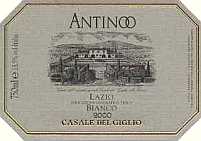
|
|
Antinoo 2000 |
|
| Casale del Giglio (Italy) | |
| Grapes: Chardonnay (66%), Viognier (34%) | |
| Price: € 8,30 | Score: |
| The wine shows a beautiful straw yellow color and nuances of greenish yellow, very transparent. The nose is elegant with intense, clean, pleasing and refined aromas of acacia, pineapple, banana, coffee, litchi, melon, peach, elder, gooseberry and vanilla. In mouth is very balanced with good correspondence to the nose, intense flavors and very agreeable. The finish is persistent with good flavors of litchi, peach, pineapple, banana and apple. A well made wine. Antinoo ages in barrique for 6-8 months followed by 6-12 months of aging in bottle. | |
| Food Match: Pasta and risotto with fish, Roasted white meat, Soft cheese | |
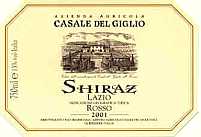
|
|
Shiraz 2001 |
|
| Casale del Giglio (Italy) | |
| Grapes: Syrah | |
| Price: € 7,20 | Score: |
| The wine has a brilliant ruby red color and nuances of ruby red, moderate transparency. The nose denotes pleasing, intense, and clean aromas of black cherry, strawberry, raspberry, carob, plum and violet followed by pleasing aromas of vanilla and black pepper. In the mouth reveals good correspondence to the nose, a slightly alcoholic attack however balanced by tannins, good body, intense flavors. The finish is persistent with flavors of raspberry, strawberry and plum. This Syrah is aged in barrique. | |
| Food Match: Roasted meat, Broiled meat and barbecue, Hard cheese | |
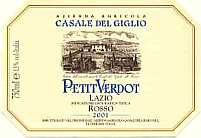
|
|
Petit Verdot 2001 |
|
| Casale del Giglio (Italy) | |
| Grapes: Petit Verdot | |
| Price: € 8,60 | Score: |
| The wine shows an intense ruby red color and nuances of ruby red, little transparency. The nose denotes good personality with intense, clean, elegant and firm aromas of black cherry, strawberry jam, hay, blueberry, plum, black currant and violet followed by good aromas of vanilla, rose, nutmeg and licorice. In mouth reveals a slightly alcoholic attack however well balanced by tannins, intense flavors and full body. The finish is persistent with good flavors of black cherry, plum and blueberry. A well made wine. This Petit Verdot is aged in barrique. | |
| Food Match: Braised and stewed meat with mushrooms, Roasted meat, Hard cheese | |
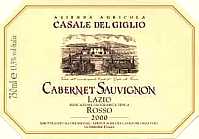
|
|
Cabernet Sauvignon 2000 |
|
| Casale del Giglio (Italy) | |
| Grapes: Cabernet Sauvignon | |
| Price: € 13,80 | Score: |
| The wine shows a beautiful and intense ruby red color and nuances of ruby red, little transparency. The nose reveals personality and pleasing, clean, intense and refined aromas of black cherry, blueberry jam, plum jam, black currant and bell pepper followed by good and intense aromas of cocoa, leather, eucalyptus, tobacco and vanilla. In the mouth has good correspondence to the nose, an evident tannic attack however balanced by alcohol, full body, intense flavors. The finish is persistent with clean flavors of black currant, black cherry and blueberry. A very well made wine which will give its best with a further aging in bottle. This Cabernet Sauvignon ages in barrique for 18-20 months followed by a further aging in bottle. | |
| Food Match: Game, Braised meat, Stewed meat, Roasted meat, Hard cheese | |
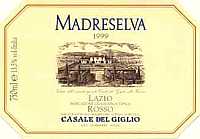
|
|
Madreselva 1999 |
|
| Casale del Giglio (Italy) | |
| Grapes: Cabernet Sauvignon (33%), Merlot (33%), Petit Verdot (33%) | |
| Price: € 11,50 | Score: |
| This wine has a beautiful and intense ruby red color and nuances of ruby red, little transparency. The nose reveals personality with intense, clean, pleasing, refined and elegant aromas of black cherry, blueberry, plum, black currant and violet followed by good and intense aromas of cocoa, coffee, leather, eucalyptus, licorice and vanilla. In the mouth has excellent correspondence to the nose, a tannic attack however well balanced by alcohol, full body, intense flavors. The finish is very persistent with long and pleasing flavors of plum, blueberry and black cherry. A very well made wine. Madreselva ages for 16-18 months in barrique followed by 4-6 months of aging in bottle. | |
| Food Match: Game, Roasted meat, Braised meat, Stewed meat, Hard cheese | |
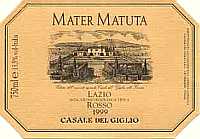
|
|
Mater Matuta 1999 |
|
| Casale del Giglio (Italy) | |
| Grapes: Syrah (85%), Petit Verdot (15%) | |
| Price: € 18,50 | Score: |
| A great wine. This wine shows an intense ruby red color and nuances of ruby red, little transparency. The nose has great personality with intense, clean, pleasing and elegant aromas of black cherry jam, blueberry, plum, black currant, violet, cyclamen, carob and black pepper followed by good aromas of vanilla, cocoa, licorice and eucalyptus. In mouth is smooth, round and very balanced with excellent correspondence to the nose, intense flavors and full body. The finish is very persistent with long and clean flavors of black cherry, plum, black currant, plum and blueberry. A very well made wine. Mater Matuta ages in barrique for 22-24 months followed by 6-8 months of aging in bottle. | |
| Food Match: Game, Braised meat, Stewed meat with mushrooms, Roasted meat, Hard cheese | |
| Casale del Giglio - Strada Cisterna - Nettuno Km. 13 - 04010 Le Ferriere, Latina (Italy) Tel. ++39 06 92902530 Fax ++39 06 92900212 - Winemaker: Paolo Tiefenthaler - Established: 1968 - Production: 500.000 bottles - E-Mail: casaledelgiglio@tin.it |
Cellar Journal |
|
This section is reserved to wine producers who want to publish news and information about their business, to announce new products or just for communicating to their customers information and promotions about their products and activity. Send news to be published at our e-mail address.
|
News |
|
In this section will be published news and information about events concerning the world of wine and food. Whoever is interested in publishing this kind of information can send us a mail at our address.
|
Matching Food with White WinesThe wines usually consumed in summertime can be perfectly matched to the preferred foods of hot days, however they also allow the matching of rich foods as well |
|
During summertime the foods which are usually consumed in this season tend to become lighter and fresher, in the table there are lots of vegetables, fish and salads, likewise wine has the same fate and in the glasses are more willingly poured white wines instead of reds, it seems color promises lightness. This generally corresponds to the truth, white wines, in particular the ones produced with some grapes or wine making techniques which give wines having a lighter structure and less alcohol, are more light and more agreeable and, at least in their appearance, they can be matched to summer foods. Indeed it should be remembered there are also full bodied white wines which would certainly appear inadequate with some dishes made of fish or vegetables, whites, just like any other wine, are produced and “created” according to the style the producer decides to give its wines. Therefore there are white wines having a light structure and little alcohol, as well as full bodied and alcoholic white wines, moreover, in case the wine was fermented or aged in cask, its organoleptic characteristics will be affected by this process as well as its structure and body; these are factors that will be scrupulously considered when a wine is to be chosen for the enogastronomical matching.
|
|
The current production of white wines seems to be less favored than red wines, that is the one which is commonly and unjustly referred as the “real wine”, and even in some areas, traditionally involved in the production of white wine, they started to pay more attention on the production of red wine. Despite the fact this is the result of commercial opportunities and choices based on what the market requests the more, there are still areas and producers who remain faithful to what they produced since ever, hopefully enriching their production with other wines, and fortunately, the offer of white wines is still rich and vast. Moreover, there are areas which are strongly associated to white wine and their fame is known everywhere, and we sincerely hope, they will continue to delight us with their excellent productions. Bourgogne, Alsace, Loire Valley, Vallée d'Aoste, Alto Adige, Friuli Venezia Giulia, Mosel, Rheingau, Austria and New Zealand are just few of the many areas or countries that could be mentioned. The choice of white wines is rather vast and every country is capable of offering interesting products for the enogastronomical matching. Besides the huge selection of wines produced everywhere and in every wine producing country of the world with the international grapes “Chardonnay”, “Sauvignon Blanc” and “Riesling”, excellent grapes indeed, interesting opportunities, and often pleasing surprises, can also be found in those wines produced with lesser known grapes and certainly this does not mean less interesting: white berried grapes are countless and every one of them is capable of giving wines with unique characteristics, capable of exalting particular enogastronomical matchings as well as to exalt themselves. France offers a wide selection of white wines and the most representative areas certainly are Alsace, Bourgogne and Loire Valley. Alsace is renowned everywhere for its refined and excellent white wines, in particular the ones produced with Muscat Blanc, Gewürztraminer, Riesling, Pinot Blanc and Silvaner grapes. The wines of this region are extremely elegant and refined, often considered as a model to follow in other wine producing countries which cultivates those grapes. Alsatian wines, undoubtedly, are excellent for enogastronomical matching. Bourgogne, indisputable homeland of Chardonnay grape, practically the only and unique white berried grape cultivated in the region, in its many areas offers a rich selection of wines produced with this grape. Chablis, Côte d'Or, Côte de Beaune, Meursault and Pouilly-Fuissé are just few examples of the excellent areas of Bourgogne where Chardonnay is being produced. Loire Valley is the homeland of Sauvignon Blanc, renowned for its Pouilly-Fumé, among the most representative areas of the region, as well as Sancerre and Touraine. Wines produced in this region with Chenin Blanc grape are interesting as well, in particular in the areas of Vouvray, and Muscadet of Sèvre-et-Maine, produced with Melon de Bourgogne grape. Other areas of France famous for the production of white wines are the Rhône Valley, in particular Côte-Rôtie and Condrieu for their wines produced with Viognier grape, Languedoc-Roussillon, Jura, Provence and Savoie. Italy, with its rich patrimony of grapes, offers a rather vast range of white wines and the enogastronomical matching should be considered as an interesting opportunity for reevaluating, or better to say, rediscovering, the countless white berried grapes varieties which are often and unfortunately forgotten in favor of the so called “international” grapes cultivated in every region of the country and used for producing excellent wine. From Vallée d'Aoste to Sicily, every region can offer wines produced with local grapes as well as international grapes which can be perfectly matched with many dishes. Because of the huge selection of white wines produced in Italy, mentioning all of them, or just a part, would require a longer report, therefore we will just mention the main white wines produced in every region. Vallée d'Aoste offers an excellent white wine, produced with Blanc de Morgex grapes, cultivated in the highest vineyards of Europe at an altitude of about 1200 meters (about 3930 feet), a delicate and aromatic wine with a pleasing crispness. Piedmont, usually known as the homeland of great red wines, produces excellent white wines with Cortese, Arneis, Favorita and Timorasso grapes. Lombardy offers good white wines produced with Trebbiano di Lugana as well as the vast production of Oltrepò Pavese. Alto Adige produces extremely elegant and refined white wines, in particular with Gewürztraminer, Müller Thurgau and Sauvignon Blanc grapes, as well as the less famous, but certainly very interesting, Veltliner, Kerner and Silvaner. In Trentino, as well as international grapes, should be mentioned its pleasing wines produced with Nosiola. In Veneto are cultivated many white berried grapes and the most representative one certainly is Garganega. Friuli Venezia Giulia has an abundant production of white wines and Tocai Friulano, Ribolla Gialla, Malvasia Istriana and Verduzzo Friulano are just few to be mentioned. Even the production of white wines of Liguria is interesting, in particular the ones produced with Pigato, Vermentino, Bosco and Albarola grapes. Albana probably is the most famous white berried grape of Emilia Romagna, however the region produces good wines with Pignoletto, Trebbiano di Romagna and Malvasia grapes. In Tuscany there is the Vernaccia di San Gimignano as well as Trebbiano Toscano and Malvasia Bianca. In Umbria is the Grechetto grape to be the most famous one, however in this region, among the many grapes, there are Trebbiano Toscano and Malvasia as well. In the Marches is the Verdicchio grape to be the most representative one which is capable of giving interesting white wines. In Latium the production of white wines is mainly based on Trebbiano Toscano, Malvasia and Trebbiano Giallo grapes. Abruzzo is certainly associated to its Trebbiano d'Abruzzo, the name used here to refer to Bombino Bianco, however there should also be mentioned Passerina and Pecorino grapes. Bombino Bianco is also cultivated in Molise as well as Falanghina and Greco. The main white berried grapes of Campania certainly are Falanghina, Fiano, Greco and Coda di Volpe, however wines produced with Asprinio and Biancolella are interesting as well. Apulia produces good white wines with Bianco d'Alessano, Verdeca, Bombino Bianco, Fiano and Malvasia grapes. Basilicata, particularly known for its red wines, produces interesting white wines with Greco Bianco and Malvasia grapes. The same is also true for Calabria where they produce white wines with Greco Bianco grape. In Sicily excel white wines produced with Grillo, Catarratto and Inzolia grapes, the same used for the production of the excellent Marsala. In Sardinia Vermentino certainly is the most famous white berried grape, however Nuragus, Nasco, Semidano and the extraordinary Vernaccia di Oristano should be mentioned as well. Germany surprises the world with its excellent white wines since ever, in particular the ones produced with Riesling, an enology model which is imitated everywhere in the world. In Austria is the Grüner Veltliner grape the most representative one, which is capable of giving very interesting wines. In Spain are produced excellent wines with the Albariño grape, very pleasing and aromatic. Even white wines of Portugal are pretty interesting according to an enogastronomical point of view, in particular the ones produced with Alvarinho and Verdelho grapes. New Zealand produces excellent white wines with Chardonnay, Sauvignon Blanc and Riesling grapes; the same grapes are also found in Australia where they also produce excellent wines with Sémillon and Chenin Blanc grapes. Interesting are also the wines produced in South Africa with Chardonnay and Sauvignon Blanc, two grapes that are also cultivated in the United States of America, Chile and Argentina. Lastly, Greek, renowned for its famous Retsina wine, produces interesting white wines with Assyrtico, Athiri and Roditis grapes.
|
||||
|
The secret of a good enogastronomical match is based on the evaluation of the organoleptic characteristics both of food and wine and how they interact one each other. Therefore, matching white wine require the knowledge of its organoleptic characteristics, both in general and specifically of the wine to be matched. In general terms, organoleptic characteristics of white wines are acidity, alcohol, the quantity of residual sugars, body, the taste-olfactory persistence and, in case of slightly sparkling wines, effervescence. In case a wine was aged in cask, this factor will also contribute to add structure to the wine as well as altering its organoleptic characteristics. Acidity is useful for the matching of those foods which have a certain “fattiness”, such as cheese and every dish which has fatty condiments, such as lard. Acidity can also be matched with foods which have a slight sweet taste, such as pasta, cereals, rich in starches, crustaceans, fish, vegetables, that is the kind of foods where a slight sensation of sweetness can be perceived and not a real and proper sweetness. Even the “mineral” organoleptic sensation in white wines, that is the sensation which vaguely resemble “salt” sometimes found in some white wines produced in the areas near the sea, can be useful for the matching of these foods, in particular with the foods having a slight sweet sensation. Even slightly sparkling wines, having an appreciable effervescence, are very useful for the matching of fatty and slightly sweet foods. In this specific case it should be remembered the action of effervescence and acidity are summed up, therefore they will be matched to foods having a particularly evident quantity of this sensations. Alcohol, besides partially contributing to the body of wine, thanks to is cleansing action, is useful with foods having unctuous substances in them, such as oil, as well as foods with elaborated and complex sauces. The quantity of residual sugars present in a white wine, and in a lesser extent, any possible aging of the wine in cask, contribute to determine the so called “roundness” of wine. This sensorial characteristic is useful for the matching of tasty foods, the ones having slightly acid tastes, such as tomato and sauces prepared with this ingredient, and slightly bitter foods, such as the tastes of certain sauces prepared with specific aromatic herbs, as well as vegetables, such as chicory. The intense aromatic persistence of a wine, abbreviated as PAI, that is the quantity of time flavors and aromas of a wine continue to be perceived after it has been swallowed, are useful for the matching of foods having the same sensorial characteristic, as well as dishes prepared with spices and aromatic herbs. A characteristic to be scrupulously considered is the structure of wine, or body, which is fuller in case it was fermented or aged in cask. This process, by passing tannins to wine, increase structure, however the body of wine is also determined by the wine making technique used for its production, the grape and how it was cultivated. The structure of a wine is usually matched to dishes having a similar structure: delicate and simple dishes require wines having little structure, whereas complex dishes having strong tastes are matched to full bodied wines. The application of this rule can make absolutely adequate a white wine with a “robust” dish that, apparently, would suggest the matching with a red wine instead.
|
Hot PepperCertainly one of the most famous and used spices, known in almost every country of the world, it is now part of the cultures of our planet |
|
Hot Pepper belongs to the family of “Solanaceae”, a very numerous family which counts 85 genders and 2200 species. The plants usually have the aspect of a bush with light green colored leaves and delicate stems. Their height varies from 40 to 80 centimeters (1.3-2.6 feet) and their width, depending on the species, is always variable from 40 to 80 centimeters. (1.3-2.6 feet)
|
|
Hot pepper was used as food since very ancient times. According to the witnesses of archaeological evidences, it is believed to be known in Mexico 9000 years ago and in 5500 BC was already present in those areas as a cultivated plant. A precise witness is offered by Montezuma's biography, last lord of Aztecs, while he was prisoner of Cortez, he spent his time joking with his concubines and eating foods with hot pepper. In Europe hot pepper was introduced by Christophorus Columbus, who brought it from America, whereas in Asia and in Africa was already known. This spice did not spread like the other spices, that is by means of the usual European trading and commercial ways, but it appears and gets spread in many parts of the world even at the same time. A classic example is offered by the so called “Cayenne pepper” or paprika (capsicum frutescens), originated from tropical America and was known in Asia and in Africa and it spread from one tribe to another.
By reading diaries of the first Columbus' expedition, it can be found out that Bartolomeo de Las Casas wrote: «the spice they eat is abundant and more important than black pepper…The doctor of Columbus' fleet, Diego Alvaro Chanca of Seville, observed that indigenous people were used to eat a very hot spice called “Agi”. It was hot pepper, he brought it to Europe where it rapidly spread with the name of “pepper of the Indies”, it was 1494. English, Spaniards, Portuguese and Dutchmen competed in acquiring the best spices' markets, bringing them from the countries where they spontaneously grew up and were cultivated, to the countries where they were unknown. Hot pepper, being a very adaptable plant, has been cultivated in many parts of the world and therefore vanished the dream of richness of many spices traders. Because of its adaptability and spreading, hot pepper became the spice of the ones who could not afford the expensive oriental spices. Mexicans used it to taste tortillas, Africans to taste manioc and Asians to taste rice, and it however became the common way to taste a simple and monotone cooking, as well as poor in proteins, a characteristics of poor people's habits in every part of the world.
|
||||||||
|
Every plant belonging to the “Solanaceae” family have something particular in common: they all contain alkaloids, therefore they all have some effects on the human nervous system. Of course, not all of them contain the same quantity of alkaloids and some of them are even used for medical preparations, such as belladonna, tobacco and stramonium. Other plants of the family have more “normal” characteristics and have become part of human nutrition, such as potato, eggplant and tomato. One of the 85 genders is capsicum to which belongs hot pepper. In the capsicum gender we have capsicum annum, capsicum frutescens, capsicum pubescens and capsicum pendulum. Capsicum annum regroups some varieties such as capsicum abbreviatum, acuminatum, fasciculatum, cerasiferum, bicolor and christmas candle. The other hundreds of capsicum spread all over the world gave origin to many types of hot pepper, having countless dimensions, shapes and tastes, which are practically impossible to categorize. Not even botanists in some cases agree. Concerning the “hot” taste, it is caused by the presence of capsaicin: there are sweet peppers, hot peppers and very hot peppers; it seems that the intensity of hotness is indirectly proportional to the size of the fruit, therefore a smaller hot pepper will be hotter than a big one. Before considering the many qualities of hot peppers, it would be appropriate to mention how the intensity of hotness is measured. The first ones to use a scale for evaluating the level of “hotness” in hot peppers were Aztecs. In their “Nahuatl” language, they could distinguish six levels: coco (hot), cocopatic (very hot), cocopetz-patic (very very hot), cocopetztic (hot fire), cocopetzquauitl (extremely hot) and cocopalatic (hot to make you flee away). The gustatory perception is a personal attitude, therefore a classification based on subjective perception is anyway approximate and certainly relative. A pharmacist from Detroit, in 1912, tried to set a method in order to measure the intensity of hotness that could be as objective as possible, at least, according to him. He investigated on what was the substance that caused hotness and how it could be possible to measure it. He took some hot peppers, among the hottest, and he singularly left them in infusion in alcohol for one night long. He used this method because, being a pharmacist, he knew capsaicin, the substance responsible for hotness, was soluble in alcohol. The morning after he took an exact quantity of liquid and he added some sugared water in definite proportions until the hotness was just perceptible. With this experiment he realized the higher the quantity of water added and the higher the hotness sensation of hot pepper was. For Habanero, considered as the hottest in the world, are needed 300.000 units of sugared water in order to have the sensation of hot just perceptible, whereas it takes 5000 units for mitigating the hotness of Poblanos species. There is another method for measuring the intensity of hotness sensation in hot peppers, also based on empirical factors: the “Dremann's Hotness Scale”, abbreviated as DHS. This method is based on the diameter of the hot pepper, without considering its length, and its capacity to increase the hotness in a sauce for units of weight. The scale used by this method indicates the ounces of sauce that can be “flavored” by adding just one ounce of fresh green hot pepper. In case of mature hot pepper the quantity must be multiplied two or three times, in case of dried hot pepper it must be multiplied ten times. However it should be observed that both methods are based on personal sensations and therefore highly empirical and relative, and that some species of hot pepper have different positions in the hotness scales used by the two methods. Among the many varieties of existing hot peppers, we will mention the characteristics of the most known and spread ones.
A particular mention should be said about the most famous sauce made of hot pepper: Tabasco sauce. For its preparation are used only hot peppers from Avery Island, Louisiana. The fruits are harvested at full ripeness, then ground, added to salt and then aged with wheat vinegar in oak casks. Tabasco has a hot taste and a pungent aroma, it is usually consumed in drops.
|
||||
|
To attenuate the hot sensation in the mouth it should be avoided to drink water, beer or wine: in this way things will only get worse. Put a pinch of salt in the tongue and then eat some bread, in particular the pulp. In Indian restaurants it is usually served yogurt in order to mitigate the effects of hot pepper. In medicine, hot pepper is used in phytotherapy, it is particularly good for alleviating muscles pain and the ones caused by arthritis, it is also a normalizer of blood pressure, benefits to blood circulation and to the heart. Capsaicin, one of the active substances of hot peppers, is contained in the placenta, a thin veil attached to the inner part of the fruit which holds seeds. Hot pepper is rich in vitamin C, which is however lost during the drying process, has antibiotics qualities and also protects from bowel diseases such as salmonella. It seems, besides for their organoleptic qualities, spices are also used because of their medical properties. Hot pepper has antibiotics, antisclerosis and anesthetic qualities. The intensity of hotness varies according to the quality and the level of ripeness, as well as seasonal conditions: drought increases the concentration of the alkaloid responsible for the hot taste. Some believe that eating spicy substances helps to eliminate calories in excess; in fact the ones who eat hot foods would eliminate more than 45 calories more than the ones who do not eat them. Hot spices would increase metabolism of about 25%. However it must be said that it is not certain yet what spices can “burn calories”. Hot pepper seems to belong to this category whereas ginger does not. The best method for keeping hot pepper in order not to have it loosing its organoleptic properties are in oil or dried, it must be used as soon as it was harvested in order to preserve its taste. In order to obtain a hot taste it is advisable to dry hot peppers under the sun and to ground them few days after harvesting. The ones who prefer to keep hot pepper in pickle, it is better to harvest them without removing stalks and seeds and to scald them in water and vinegar for one minute. Therefore boiling one liter of water in a pot (33.8 fl.oz.), stop fire and add 250 grams of salt (8.8 oz.), cool them down and put hot peppers in a glass pot. In cooking it is better to use it as a whole in order to esily spot it and to remove it at the end of cooking. It should be remembered that the more hot pepper is cooked the more it passes its hot taste to foods, therefore it is preferable to add it almost at the end in case it is wished a food not excessively hot.
|
Wine Parade |
|
|
| The best 15 wines according to DiWineTaste's readers. To express your best three wines send us an E-mail or fill in the form available at our WEB site. |
| Rank | Wine, Producer | |
|---|---|---|
| 1 |
| Capo di Stato 1998, Conte Loredan Gasparin |
| 2 |
| Masseto 1998, Tenuta dell'Ornellaia |
| 3 |
| Teroldego Rotaliano Granato 1998, Foradori |
| 4 |
| Château Laroque Saint-Émilion Grand Cru Classè 1998 |
| 5 |
| Colli Bolognesi Pignoletto Superiore “Prova d'Autore” 2001, Bonfiglio |
| 6 |
| Shiraz 2000, Plantaganet |
| 7 |
| Château Lynch-Bages Pauillac 2000 |
| 8 |
| Semillon Sauvignon 2001, Cape Mentelle |
| 9 |
| Sauvignon Blanc 2000, Cakebread |
| 10 |
| Fumé Blanc Napa Valley 2001, Grgich Hills |
| 11 |
| Franciacorta Cuvée Annamaria Clementi 1996, Ca' del Bosco |
| 12 |
| Trentino Bianco Villa Margon 2000, Fratelli Lunelli |
| 13 |
| Muffato della Sala 1999, Castello della Sala |
| 14 |
| Margaux 2000, Ségla |
| 15 |
| Pinot Noir 1998, Mountadam |
Classified |
|
|
| In this column we will publish your classifieds. Send your classified, with a length up to 255 characters, to our staff |
| |||||||
Privacy Policy | |||||||


| Copyright © 2002-2024 Antonello Biancalana, DiWineTaste - All rights reserved |
| All rights reserved under international copyright conventions. No part of this publication and of this WEB site may be
reproduced or utilized in any form or by any means, electronic or mechanical, without permission in writing from DiWineTaste. |